How Grit Framework and Grit Workbook Aligns to Florida's Resiliency Standards
India White • July 15, 2024
How G.R.I.T Framework and G.R.I.T. Workbook Align to Resiliency Standards!

How the G.R.I.T Framework and G.R.I.T. Workbook Align to Florida Resiliency Standards
Dr. India White's GREAT Resilience In Time (G.R.I.T.) Workbook for Teachers, her G.R.I.T. Framework, and her TEDx talk "The Power of Grit" align comprehensively with the Florida Health Standards and the 11 Resiliency Skills outlined in Section 1003.42(2)(n)4., Florida Statutes (F.S.). These standards emphasize essential life skills that build confidence, support mental and emotional health, and enable students to overcome challenges. Here’s a detailed explanation of this alignment:
I. Self-awareness and Self-management
Dr. White's G.R.I.T. Framework includes a self-assessment component that encourages teachers and students to reflect on their resilience, growth mindset, self-efficacy, and time management. This self-awareness is foundational for effective self-management. By understanding their strengths and areas for improvement, individuals can better regulate their emotions and behaviors, aligning with the self-awareness and self-management goals of the standards.
1) Responsible Decision-making
The G.R.I.T. Workbook provides practical exercises and scenarios that help students and teachers make thoughtful and informed decisions. By fostering a growth mindset, Dr. White emphasizes the importance of perseverance and dedication, encouraging responsible decision-making that considers long-term outcomes rather than immediate gratification.
II. Resiliency
Resiliency is a core focus of Dr. White’s G.R.I.T. resources. Her TEDx talk highlights the ability to bounce back from setbacks and maintain a positive outlook in the face of adversity. The workbook includes specific activities to build resilience, such as reflective questions and goal-setting exercises that encourage students to persist through challenges.
III. Relationship Skills and Conflict Resolution
Dr. White’s emphasis on a growth mindset and understanding diverse perspectives promotes better relationship skills and conflict resolution. By encouraging empathy and open-mindedness, her framework helps students navigate interpersonal conflicts and build stronger, more respectful relationships.
IV. Understanding and Respecting Other Viewpoints and Backgrounds
The G.R.I.T. Framework’s focus on a growth mindset also supports the understanding and respect for diverse viewpoints. Dr. White teaches that challenges and failures are opportunities for growth, which includes learning from others' experiences and perspectives.
V. Developing Leadership and Interpersonal Skills (Grades 9-12)
For high school students, Dr. White’s resources address the development of leadership, interpersonal skills, organization skills, and other critical life skills. Her workbook includes exercises on goal setting, time management, and self-efficacy, which are essential for creating resumes, exploring career pathways, and preparing for employment. These activities align with the standards' focus on preparing students for future careers and responsibilities.
VI. Florida Health Standards Alignment
Dr. White’s G.R.I.T. Framework aligns with the Florida Health Standards, specifically HE.912.R.4.1, which emphasizes the importance of character and grit in achieving successful outcomes. By teaching students to persevere, manage stress, and stay motivated, Dr. White’s resources directly support these educational goals.
VII. Alignment with 11 Resiliency Skills
Dr. India White’s G.R.I.T. Framework and Workbook are meticulously aligned with the 11 resiliency skills outlined in Florida's educational standards. Each skill is addressed through specific components of the framework, fostering comprehensive personal and professional development.
1. Grit
Dr. White’s G.R.I.T. Framework is fundamentally designed to cultivate grit, defined as the combination of passion and perseverance toward long-term goals. Through her self-assessment tools and reflective exercises, teachers and students are encouraged to identify their core passions and commit to pursuing them persistently. This focus on sustained effort and dedication, even in the face of challenges, embodies the essence of grit, helping individuals to build a strong, resilient character that is essential for success.
2. Resilience
Resilience is explicitly addressed within the resilience category of Dr. White's G.R.I.T. Framework. The workbook includes activities and questions that prompt individuals to reflect on their ability to bounce back from setbacks and adapt to change. By encouraging the practice of maintaining a positive outlook and developing strategies to overcome obstacles, Dr. White’s resources help students and teachers build resilience, ensuring they can recover from difficulties and continue moving forward with determination.
3. Perseverance
Perseverance is a recurring theme in both the growth mindset and resilience components of the G.R.I.T. Framework. Dr. White emphasizes the importance of persistence through failure and challenges, teaching that setbacks are opportunities for growth and learning. Through guided exercises, individuals are encouraged to set long-term goals, develop a plan to achieve them, and remain committed to their efforts despite difficulties. This relentless pursuit of goals is a key aspect of perseverance.
4. Gratitude
Gratitude is fostered through the self-reflection and positive outlook promoted by Dr. White's framework. The workbook encourages individuals to regularly reflect on their progress and appreciate the small victories along their journey. This practice of acknowledging and valuing positive experiences and contributions helps build a mindset of gratitude, which is crucial for maintaining a balanced and positive perspective in both personal and professional life.
5. Responsibility
Responsibility is promoted through the self-efficacy and responsible decision-making exercises within the G.R.I.T. Framework. By guiding individuals to take ownership of their actions, set realistic goals, and make informed decisions, Dr. White’s resources help foster a sense of responsibility. Teachers and students learn to be accountable for their progress and setbacks, understanding that their actions directly impact their success and well-being.
6. Responsible Decision-making
Responsible decision-making is integrated throughout the G.R.I.T. Framework, particularly in scenarios and reflective questions that challenge individuals to consider the consequences of their choices. Dr. White provides practical tools and exercises that help individuals weigh their options, think critically about potential outcomes, and make decisions that align with their long-term goals and values. This emphasis on thoughtful and informed decision-making is crucial for personal and professional growth.
7. Self-awareness
Self-awareness is central to the self-assessment component of the G.R.I.T. Framework. Dr. White encourages individuals to reflect deeply on their strengths, weaknesses, and areas for improvement. This heightened self-awareness allows individuals to understand their motivations, recognize their emotional responses, and make adjustments to their behavior that promote personal growth and effective self-management.
8. Self-management
Self-management is developed through the time management and self-efficacy activities within Dr. White’s framework. By teaching individuals how to prioritize tasks, set realistic goals, and manage their time effectively, the G.R.I.T. Workbook helps them develop the skills needed to regulate their behavior and stay focused on their objectives. These self-management skills are essential for achieving long-term success and maintaining a balanced life.
9. Mentorship
Mentorship is encouraged as part of relationship skills and supporting others within the G.R.I.T. Framework. Dr. White emphasizes the importance of building strong, supportive relationships and seeking guidance from experienced mentors. The workbook includes exercises that prompt individuals to reflect on their role as mentors and mentees, fostering a culture of support, collaboration, and mutual growth.
10. Citizenship
Citizenship is promoted through the emphasis on understanding and respecting diverse viewpoints and backgrounds. Dr. White’s framework teaches individuals to value different perspectives, fostering a sense of community and social responsibility. By encouraging empathy and open-mindedness, the G.R.I.T. Workbook helps students and teachers become active, respectful, and engaged members of their communities.
11. Honesty and Empathy
Honesty and empathy are integral to the relationship skills and conflict resolution components of the G.R.I.T. Framework. Dr. White’s resources teach individuals to communicate openly and honestly, while also understanding and respecting others’ feelings and perspectives. This focus on genuine, empathetic interactions helps build trust, resolve conflicts effectively, and foster healthy, supportive relationships.
In conclusion, Dr. India White’s G.R.I.T. Workbook for Teachers, her G.R.I.T. Framework, and her TEDx talk are meticulously aligned with Florida’s resilience standards. They provide comprehensive strategies to develop essential life skills, fostering a growth mindset and building resilience in both students and teachers, ensuring they are equipped to thrive in various aspects of life.

New Book Launch: The G.R.I.T. Prayer Guide for Apostolic Believers — Now Available on Amazon I’m thrilled to announce the release of my newest devotional, The G.R.I.T. Prayer Guide for Apostolic Believers, now available on Amazon. Order your copy here: https://www.amazon.com/dp/B0FXS7FZSY?ref_=pe_93986420_774957520 This 365-day devotional and prayer journal was written for Apostolic believers who are striving to live a holy, Spirit-led life while growing in perseverance, prayer, and power. Built upon the biblical foundation of Acts 2:38-39; Acts 2:42, this guide invites you to strengthen your walk with God by developing daily habits of prayer, reflection, and spiritual growth. The G.R.I.T. Prayer Guide for Apostolic Believers is more than a journal—it’s a spiritual journey designed to help you build G.R.I.T., which stands for: * Growth Mindset – Renew your mind daily through the Word, embracing God’s promises with faith and expectation. * Resilience – Stand strong in the Apostolic faith, enduring trials with steadfastness and joy in the Holy Ghost. * Self-Efficacy – Believe that through the Spirit, you can live victoriously, walking in righteousness and truth. * Time Management – Dedicate daily time to prayer, fasting, worship, and studying the Scriptures to stay spiritually disciplined. This prayer guide empowers Pentecostal and Apostolic believers to pursue holiness and purpose. Each day includes space for prayer, reflection, and gratitude— helping you cultivate a lifestyle of devotion that keeps your heart fixed on God. Whether you are new to the faith or a seasoned believer, this devotional is a valuable resource to help you stay anchored in God’s Word, develop endurance, and walk boldly in Apostolic identity. As you journey through the year, you will find yourself strengthened by Scripture, renewed in purpose, and ignited with spiritual fire. Just as I shared in my TEDx Talk, “The Power of G.R.I.T.,” this guide reminds us that G.R.I.T. means Great Resilience In Time. Through prayer and daily devotion, Apostolic believers can develop the spiritual resilience needed to withstand the storms of life while staying faithful to the Lord’s calling. Use this devotional as part of your morning or evening prayer routine, during fasting seasons, or in group study with fellow believers. Let it become a tool that draws you deeper into the presence of God and helps you grow in both discipline and anointing. Order Your Copy Today The G.R.I.T. Prayer Guide for Apostolic Believers is now available on Amazon at: https://www.amazon.com/dp/B0FXS7FZSY?ref_=pe_93986420_774957520 May this guide strengthen your walk with God, deepen your prayer life, and help you live with Great Resilience In Time—for His glory. For ministry connections, speaking engagements, or more G.R.I.T. resources, visit me at www.india-white.com. Grab Your Copy from Amazon Today!

New Book Launch: The G.R.I.T. Journal for Apostolic Believers — A 365-Day Journey of Prayer, Power, and Purpose I am overjoyed to announce the release of my newest devotional resource, The G.R.I.T. Journal for Apostolic Believers! This powerful 365-day journal was prayerfully designed to help Apostolic Christians strengthen their walk with God through daily devotion, reflection, and intentional growth in holiness. In a world filled with distractions and compromise, Apostolic believers are called to stand firm in truth and righteousness. This journal serves as a spiritual companion to help you cultivate a life that is rooted in the Apostles’ doctrine, empowered by the Holy Ghost, and aligned with God’s will. The G.R.I.T. Framework —Growth Mindset, Resilience, Self-Efficacy, and Time Management —provides a faith-based structure for spiritual discipline and endurance. As you journey through the pages, you will be inspired to: * Grow daily in your knowledge of the Word, prayer, and Apostolic doctrine. * Develop Resilience to remain steadfast in your faith, even when faced with trials or opposition. * Strengthen Self-Efficacy, trusting that through the Holy Ghost you have the power to live a victorious life. * Manage Your Time with intention, dedicating each day to prayer, worship, fasting, and service for the Lord. This journal is built on the foundation of **Acts 2:42**, where the early church “continued steadfastly in the apostles’ doctrine and fellowship, and in breaking of bread, and in prayers.” Each page encourages you to take time daily to seek God’s presence, apply Scripture, and live a life that pleases Him. The G.R.I.T. Journal for Apostolic Believers promotes Pentecostal holiness living—separation from the world, consecration unto God, and a heart committed to righteousness. Through daily reflections, prayer journaling, and gratitude writing, you will draw closer to Jesus and be reminded of your purpose as a vessel for His glory. This journal can be used as part of your daily devotion, during morning prayer, in fasting seasons, or alongside Bible study. It is a tool to help you remain spiritually grounded and encouraged as you strive to walk in the Spirit and fulfill God’s calling on your life. Use it to: * Record your daily prayers, Scriptures, and answered petitions. * Reflect on how God is molding your character and faith. * Strengthen your spiritual focus through intentional journaling. * Prepare your heart for revival and continual renewal in the Holy Ghost. The G.R.I.T. Journal for Apostolic Believers was inspired by the same message I shared in my TEDx Talk, “The Power of G.R.I.T.”—which stands for Great Resilience In Time. For the Apostolic believer, this resilience is found in living for Christ daily, enduring trials with joy, and pressing toward the mark of the high calling of God in Christ Jesus. Order Your Copy Today The G.R.I.T. Journal for Apostolic Believers is now available on Amazon: Paperback copy! Whether you are a minister, prayer warrior, youth leader, or believer striving to please the Lord, this devotional will help you stay rooted in Apostolic truth and live a life that honors God in every thought, word, and deed. About the Author Dr. India White is a national speaker, educator, and author who passionately empowers believers to develop Great Resilience In Time through faith and spiritual discipline. As a baptized, Spirit-filled believer who lives by the Apostolic doctrine, she is dedicated to helping others grow in holiness, faith, and purpose. Through her ministry and her G.R.I.T. Framework, she equips the body of Christ to endure with strength, walk in integrity, and live a life of consecration to the Lord. To learn more or invite Dr. White to your church, conference, or women’s ministry event, visit [www.india-white.com]

New Book Launch: The G.R.I.T. Prayer Journal — A 365-Day Devotional Journey of Faith and Perseverance I am beyond excited to announce the launch of my newest book, The G.R.I.T. Prayer Journal: A 365-Day Devotional Journey! This journal was created to help believers strengthen their relationship with God, build spiritual endurance, and live with purpose every single day. The G.R.I.T. Prayer Journal is more than just a devotional—it’s a transformational journey designed to help you develop G.R.I.T., which stands for Growth Mindset, Resilience, Self-Efficacy, and Time Management. These four pillars are essential not only for success in life but also for spiritual maturity. As you walk through each day of this 365-day devotional, you’ll be encouraged to: * Grow in your faith and mindset by applying God’s Word to daily life. * Build Resilience by trusting God’s promises during times of struggle and uncertainty. * Develop Self-Efficacy, believing that you can do all things through Christ who strengthens you. * Manage Your Time Wisely, creating space each day to pray, reflect, and renew your spirit. This journal was born out of my own experiences with perseverance—the same message I shared in my TEDx Talk, “The Power of G.R.I.T.” In that talk, I reminded the world that G.R.I.T. stands for Great Resilience In Time—the ability to endure, overcome, and rise stronger through every challenge life presents. The same faith and determination that carried me through seasons of difficulty have been woven into the pages of this devotional. Every page of The G.R.I.T. Prayer Journal invites you to reflect on Scripture, record your prayers, and recognize how God is moving in your life. It’s designed for believers who want to deepen their walk with God, grow in faith, and live each day with hope and purpose. Whether you are just starting your faith journey or have been walking with the Lord for years, this devotional will help you remain steadfast, prayerful, and full of grace. Order Your Copy Today The G.R.I.T. Prayer Journal is now available on Amazon today! Paperback For speaking engagements, ministry collaborations, or to learn more about my G.R.I.T. Framework and resources, please visit my website or contact me directly. About the Author Dr. India White is a national speaker, educator, author, and TEDx presenter known for her inspiring message of perseverance and faith. As the founder of G.R.I.T. Academy, she empowers students, leaders, and believers to grow through challenges and build lasting resilience.
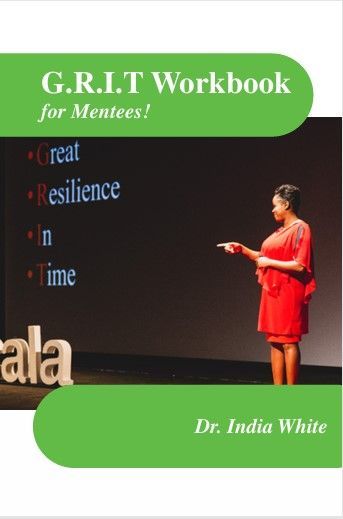
# The Power of Grit in Mentoring: A Leader’s Playbook for Building Perseverance, Confidence, and Achievement Mentoring changes lives when it moves beyond encouragement and becomes a disciplined, relationship-centered system for **building grit**—the daily habits of perseverance that help mentees finish what they start, grow through setbacks, and become resilient, self-directed learners. In my **G.R.I.T. Framework**—**Growth Mindset, Resilience, Self-Efficacy, and Time Management**—mentors learn to coach behaviors and beliefs that compound over time. This blog synthesizes what research says about grit and mentoring, translates those findings into practical tools for mentors, and shows leaders how to implement a high-fidelity mentoring model in schools, districts, churches, nonprofits, and teams. It also points to resources in my **GRIT Workbooks** and **GRIT Trainings**, and it connects with principles from my **TEDx talk, “The Power of Grit.”** Leaders: share this with your mentor corps. Every section below includes specific actions and measurable indicators you can put to work right away. --- ## Why Grit Matters in Mentoring (What the Evidence Actually Shows) Across multiple contexts, grit—defined as “perseverance and passion for long-term goals”—predicts meaningful differences in success. In seminal studies, grit accounted for about **4% of the variance** in outcomes such as Ivy League GPA, **West Point** retention, educational attainment, and **National Spelling Bee** rankings (Duckworth 2007). Importantly, follow-up research at West Point shows that **both** initial fitness and grit significantly predict **four-year retention** through graduation, underscoring that noncognitive traits and tangible preparation work together (Wetzler et al. 2023). At the same time, the strongest meta-analysis to date urges nuance: the **perseverance-of-effort** facet (showing up and doing the work) tends to carry more predictive weight than the **consistency-of-interests** facet, and grit overlaps with conscientiousness more than early popular narratives suggested (Credé, Tynan, and Harms 2017). For leaders, the takeaway is practical: coach **repeatable effort routines** and **structured practice**, not slogans. Grit connects tightly to other malleable drivers. A national, randomized study of U.S. high schools found a brief **growth-mindset** intervention improved grades **for lower-achieving students** and increased enrollment in advanced math, **when schools provided supportive contexts**—clear work routines, challenge with care, and timely feedback (Yeager et al. 2019). A meta-analysis on mindsets also concluded that average effects are **small overall** but stronger for at-risk learners and when paired with concrete supports (Sisk et al. 2018). This is a crucial design lesson for mentoring: pair belief-shifts with **structure**. Two more pillars round out the picture. **Self-efficacy**—students’ belief in their ability to execute tasks—shows **robust, positive relations** with academic performance and persistence across decades of research (Multon, Brown, and Lent 1991; Artino 2012). And **time management** routines reliably improve engagement, reduce stress, and relate to performance, especially when defined as **specific planning behaviors** (Aeon and Aguinis 2017; Aeon, Faber, and Panaccio 2021). Newer work continues to link time-planning habits to higher study engagement via improved self-control and reduced distraction (Fu et al. 2025). Finally, **mentoring itself works**—and works best when it follows evidence-based practices. Meta-analyses show **modest average effects overall**, with **larger effects** when programs build high-quality relationships, set clear goals, and use structured activities (DuBois et al. 2011; Eby et al. 2008; Raposa et al. 2019). For leaders, that means your implementation fidelity—not just your enthusiasm—determines your impact. --- ## The G.R.I.T. Framework for Mentors (What to Coach and How) **Growth Mindset.** Mentors help mentees interpret effort and struggle as **signals for strategy change**, not signs of incapacity. Replace “I’m not good at this” with “I’m not there **yet**—what’s my next step?” Pair language with specific practice plans, because mindset effects scale **when** learners get structured opportunities to practice and see improvement (Sisk et al. 2018; Yeager et al. 2019). Three to four sentences of encouragement cannot substitute for a calendar of deliberate work. **Resilience.** Reframe setbacks using a two-question reset: **What did I try? What will I try next?** Evidence from competitive contexts shows that gritty performers invest in **deliberate practice**—effortful, targeted repetitions with feedback—even when it’s not enjoyable. In the National Spelling Bee, deliberate solo practice predicted performance better than quizzing or leisure reading, and time in deliberate practice **mediated** the link between grit and outcomes (Duckworth et al. 2010/2011). Mentors should therefore normalize “productive discomfort” and monitor the **dose** of high-quality practice. **Self-Efficacy.** Confidence grows through **mastery experiences**—visible progress on tasks. Mentors should break complex goals into **manageable skills**, track micro-wins, and spotlight progress evidence (“You solved 6/10 correctly last week and 8/10 today after switching strategies”). This is the mechanism by which efficacy fuels persistence and performance (Multon, Brown, and Lent 1991; Artino 2012). **Time Management.** Grit needs a calendar. Adopt a weekly rhythm: two to three **30-minute focus blocks**, a **review/reflect** block, and **micro-deadlines**. The literature shows that when “time management” is treated as specific planning behaviors—rather than a vague trait—benefits are clearer for well-being, engagement, and performance (Aeon and Aguinis 2017; Aeon, Faber, and Panaccio 2021; Fu et al. 2025). --- ## A Six-Step Mentoring Playbook (Leader-Ready and Measurable) **Step 1 — Define one outcome and two behaviors.** Clarify a concrete goal (e.g., “Raise Algebra quiz average from 68% to 78% in four weeks”) and two behaviors that produce it (“Complete three targeted practice sets per week; attend one help session”). Clarity fuels efficacy and execution (Multon, Brown, and Lent 1991). **Step 2 — Build a weekly plan.** Schedule **two focused blocks** and one **review block** on the mentee’s calendar. Treat practice like a rehearsal—non-negotiable and protected. Research suggests that structured planning is the tractable unit of “time management” that mentors can coach consistently (Aeon and Aguinis 2017; Aeon, Faber, and Panaccio 2021). **Step 3 — Practice deliberately.** Use **model → guided reps → independent reps** with tight feedback loops. Keep challenge just above current skill. In high-stakes learning, deliberate practice—not generic repetition—drives the gains that gritty students realize (Duckworth et al. 2010/2011). **Step 4 — Track micro-wins.** Use a single-page tracker: attempts, errors spotted, fixes tried, score trend. Visible progress is the fuel for self-efficacy, and self-efficacy, in turn, sustains persistence (Multon, Brown, and Lent 1991; Artino 2012). **Step 5 — Debrief with AAA: Acknowledge, Analyze, Adjust.** Affirm effort (“You protected your study blocks”), analyze strategy (“What worked?”), then adjust (“Next week: swap one 30-minute block to mornings”). This keeps the relationship warm and the expectations high—two hallmarks of effective mentoring programs (DuBois et al. 2011; Raposa et al. 2019). **Step 6 — Protect the relationship.** Set predictable check-ins and open with a brief relational scan (“High/Low of the week?”). Meta-analytic reviews show that relationship quality magnifies mentoring effects across domains (Eby et al. 2008; Raposa et al. 2019). Leaders should train mentors to balance **care** with **challenge** every week. --- ## Field-Tested Tips Mentors Can Use Tomorrow **Make struggle normal and specific.** Say: *“This is hard because you’re learning. Let’s try a smaller step and track it.”* Then define the step and where it goes on the calendar. This converts a mindset cue into a behavior (Sisk et al. 2018; Yeager et al. 2019). **Coach the dose of practice.** Ask: *“Show me 20 minutes of deliberate reps on the three hardest problem types, then text me your tracker.”* In competitive settings, deliberate practice time is the pathway through which grit shows its effect (Duckworth et al. 2010/2011). **Anchor confidence in evidence.** Prompt: *“Identify one place you improved since last week, and what you changed to get there.”* Efficacy grows when improvement is linked to controllable strategies (Multon, Brown, and Lent 1991; Artino 2012). **Keep time visible.** Mentor: *“Open your planner—where are the two 30-minute blocks this week?”* Mentoring that operationalizes time as scheduled behaviors produces more reliable gains (Aeon and Aguinis 2017; Aeon, Faber, and Panaccio 2021; Fu et al. 2025). --- ## Measuring Impact (So Leaders Can See What’s Working) Build a simple dashboard that blends **outcomes**, **process**, and **beliefs**: * **Outcome metrics:** course grades, attendance, certification steps completed, or project milestones. * **Process metrics:** number of focused study blocks completed; number of deliberate-practice reps; number of mentor feedback cycles per week. * **Belief metrics:** 4-item pulse on growth mindset and self-efficacy (e.g., “I can improve with practice; I know my next step”). Track weekly. Coach **behavioral fidelity** first (Did we do the blocks? the reps? the debriefs?) before adjusting goals. This mirrors what high-impact mentoring programs do at scale—focus on the controllables, then iterate (DuBois et al. 2011; Raposa et al. 2019; Eby et al. 2008). --- ## Implementation Pitfalls Leaders Should Avoid (And What to Do Instead) **Pitfall 1: “Mindset talk” without practice plans.** **Fix:** Pair every encouragement with a **specific, scheduled action**. The strongest studies show mindset affects achievement most when aligned with structure and supportive contexts (Yeager et al. 2019; Sisk et al. 2018). **Pitfall 2: Treating grit as personality, not practice.** **Fix:** Emphasize the **perseverance-of-effort** behaviors. Remember that grit overlaps with conscientiousness and works mainly through consistent, high-quality effort (Credé, Tynan, and Harms 2017). **Pitfall 3: Vague time-management advice.** **Fix:** Define time management as **two to three protected blocks + one review block + micro-deadlines**. Contemporary reviews favor concrete planning over broad platitudes (Aeon and Aguinis 2017; Aeon, Faber, and Panaccio 2021; Fu et al. 2025). **Pitfall 4: Relationship drift.** **Fix:** Train mentors to open with connection, close with commitments, and log each session. Meta-analyses consistently link **relationship quality** to larger effects (Raposa et al. 2019; Eby et al. 2008). --- ## How the GRIT Workbooks and Trainings Support Your Mentoring Program My **GRIT Workbooks** (Students, Educators, and Clergy) provide ready-to-use trackers, reflection prompts, mentor scripts, and weekly planning pages aligned with the **G.R.I.T. Framework**. The tools are designed so mentors can implement the **six-step playbook** immediately and leaders can monitor fidelity with simple checklists. In **GRIT Trainings**, teams practice coaching micro-skills (e.g., moving from praise to evidence-based efficacy), calibrate deliberate-practice tasks in core subjects, and learn to set up dashboards that blend outcomes, process, and belief metrics. I also integrate key moments from my **TEDx talk “The Power of Grit,”** tailoring examples for schools, districts, youth ministries, and community organizations. For details, **visit my website** to explore coaching, keynotes, and full implementation support. --- ## A Final Charge to Leaders Grit is not a slogan; it is a **system**—of beliefs, behaviors, and relationships, repeated weekly, measured carefully, and refined relentlessly. When mentors coach **Growth Mindset** with structure, build **Resilience** through deliberate practice, cultivate **Self-Efficacy** with visible mastery, and protect **Time** on the calendar, mentees don’t merely cope—they **excel**. The research is clear that effects are **real but modest** on average; the magic happens when leaders insist on fidelity to **high-quality routines** and **caring, high-expectations relationships**. Equip your mentors with the GRIT playbook, and watch perseverance, confidence, and achievement rise—one well-planned week at a time. If you want a plug-and-play mentor toolkit, a GRIT keynote, or a customized training and evaluation plan for your organization, reach out. I’d be honored to help your mentors—and mentees—grow strong, finish well, and shine. --- ## References (Chicago Author–Date) Aeon, Brad, and Herman Aguinis. 2017. “It’s About Time: New Perspectives and Insights on Time Management.” *Academy of Management Perspectives* 31 (4): 309–30. [https://doi.org/10.5465/amp.2016.0166](https://doi.org/10.5465/amp.2016.0166). ([Academy of Management Journals][1]) Aeon, Brad, Thomas Faber, and Alexander Panaccio. 2021. “Does Time Management Work? A Meta-Analysis.” *PLOS ONE* 16 (1): e0245066. [https://doi.org/10.1371/journal.pone.0245066](https://doi.org/10.1371/journal.pone.0245066). ([PLOS][2]) Artino, Anthony R., Jr. 2012. “Academic Self-Efficacy: From Educational Theory to Instructional Practice.” *Perspectives on Medical Education* 1 (2): 76–85. [https://doi.org/10.1007/s40037-012-0012-5](https://doi.org/10.1007/s40037-012-0012-5). ([PubMed Central][3]) Credé, Marcus, Michael C. Tynan, and Peter D. Harms. 2017. “Much Ado about Grit: A Meta-Analytic Synthesis of the Grit Literature.” *Journal of Personality and Social Psychology* 113 (3): 492–511. [https://pubmed.ncbi.nlm.nih.gov/27845531/](https://pubmed.ncbi.nlm.nih.gov/27845531/). ([PubMed][4]) DuBois, David L., Nelson Portillo, Jean E. Rhodes, Naida Silverthorn, and Jeffrey C. Valentine. 2011. “How Effective Are Mentoring Programs for Youth? A Systematic Assessment of the Evidence.” *Psychological Science in the Public Interest* 12 (2): 57–91. [https://doi.org/10.1177/1529100611414806](https://doi.org/10.1177/1529100611414806). ([PubMed][5]) Duckworth, Angela L. 2007. “Grit: Perseverance and Passion for Long-Term Goals.” *Journal of Personality and Social Psychology* 92 (6): 1087–1101. [https://pubmed.ncbi.nlm.nih.gov/17547490/](https://pubmed.ncbi.nlm.nih.gov/17547490/). ([PubMed][6]) Duckworth, Angela L., Teri A. Kirby, Eli Tsukayama, Heather Berstein, and K. Anders Ericsson. 2011. “Deliberate Practice Spells Success: Why Grittier Competitors Triumph at the National Spelling Bee.” *Social Psychological and Personality Science* 2 (2): 174–81. [https://doi.org/10.1177/1948550610385872](https://doi.org/10.1177/1948550610385872). ([SAGE Journals][7]) Eby, Lillian T., Tammy D. Allen, Sarah C. Evans, Thomas Ng, and David L. DuBois. 2008. “Does Mentoring Matter? A Multidisciplinary Meta-Analysis Comparing Mentored and Non-Mentored Individuals.” *Journal of Vocational Behavior* 72 (2): 254–67. [https://pmc.ncbi.nlm.nih.gov/articles/PMC2352144/](https://pmc.ncbi.nlm.nih.gov/articles/PMC2352144/). ([PubMed Central][8]) Fu, Yilin, Jiahui Yu, and Shuqin Li. 2025. “Unlocking Academic Success: The Impact of Time Management on College Students’ Study Engagement.” *BMC Psychology* 13 (1): 258. [https://pmc.ncbi.nlm.nih.gov/articles/PMC11967054/](https://pmc.ncbi.nlm.nih.gov/articles/PMC11967054/). ([PubMed Central][9]) Multon, Karen D., Steven D. Brown, and Robert W. Lent. 1991. “Relation of Self-Efficacy Beliefs to Academic Outcomes: A Meta-Analytic Investigation.” *Journal of Counseling Psychology* 38 (1): 30–38. [https://eric.ed.gov/?id=EJ426706](https://eric.ed.gov/?id=EJ426706). ([ERIC][10]) Raposa, Elizabeth B., Jean E. Rhodes, Sarah B. Stams, R. Schwartz, Carla Cardoso, et al. 2019. “The Effects of Youth Mentoring Programs: A Meta-Analysis of Outcome Studies.” *Journal of Youth and Adolescence* 48: 423–43. [https://www.rhodeslab.org/wp-content/uploads/2019/01/Raposa2019_Article_TheEffectsOfYouthMentoringProg.pdf](https://www.rhodeslab.org/wp-content/uploads/2019/01/Raposa2019_Article_TheEffectsOfYouthMentoringProg.pdf). ([rhodeslab.org][11]) Sisk, Victoria F., Alexander P. Burgoyne, Jingze Sun, Jennifer L. Butler, and Brooke N. Macnamara. 2018. “To What Extent and Under Which Circumstances Are Growth Mind-Set Interventions Effective? A Meta-Analysis of the Evidence.” *Psychological Science* 29 (4): 549–71. [https://journals.sagepub.com/doi/10.1177/0956797617739704](https://journals.sagepub.com/doi/10.1177/0956797617739704). ([SAGE Journals][12]) Wetzler, Elisheva L., Max Karstoft, John J. Ratey, Michael J. Matthews, and Yuval Neria. 2023. “Grit and Uncertainty: Grit Predicts Performance and West Point Graduation.” *Scientific Reports* 13: 11707. [https://pmc.ncbi.nlm.nih.gov/articles/PMC11407409/](https://pmc.ncbi.nlm.nih.gov/articles/PMC11407409/). ([PubMed Central][13]) Yeager, David S., Paul Hanselman, Gregory M. Walton, Jared S. Murray, Robert Crosnoe, et al. 2019. “A National Experiment Reveals Where a Growth Mindset Improves Achievement.” *Nature* 573 (7774): 364–69. [https://www.nature.com/articles/s41586-019-1466-y](https://www.nature.com/articles/s41586-019-1466-y). ([Nature][14]) --- *If you’d like this blog converted into a branded PDF, a leader’s one-pager, or a mentor session script packet aligned to the GRIT Workbooks (with trackers, planning pages, and fidelity checklists), say the word and I’ll package it for immediate use.* [1]: https://journals.aom.org/doi/10.5465/amp.2016.0166?utm_source=chatgpt.com "It's About Time: New Perspectives and Insights on ..." [2]: https://journals.plos.org/plosone/article?id=10.1371%2Fjournal.pone.0245066&utm_source=chatgpt.com "Does time management work? A meta-analysis | PLOS One" [3]: https://pmc.ncbi.nlm.nih.gov/articles/PMC3540350/?utm_source=chatgpt.com "Academic self-efficacy: from educational theory to instructional ..." [4]: https://pubmed.ncbi.nlm.nih.gov/27845531/?utm_source=chatgpt.com "Much ado about grit: A meta-analytic synthesis of the grit ..." [5]: https://pubmed.ncbi.nlm.nih.gov/26167708/?utm_source=chatgpt.com "How Effective Are Mentoring Programs for Youth? A ..." [6]: https://pubmed.ncbi.nlm.nih.gov/17547490/?utm_source=chatgpt.com "Grit: perseverance and passion for long-term goals" [7]: https://journals.sagepub.com/doi/10.1177/1948550610385872?utm_source=chatgpt.com "Deliberate Practice Spells Success" [8]: https://pmc.ncbi.nlm.nih.gov/articles/PMC2352144/?utm_source=chatgpt.com "Does Mentoring Matter? A Multidisciplinary Meta-Analysis ..." [9]: https://pmc.ncbi.nlm.nih.gov/articles/PMC11967054/?utm_source=chatgpt.com "Unlocking academic success: the impact of time management ..." [10]: https://eric.ed.gov/?id=EJ426706&utm_source=chatgpt.com "EJ426706 - Relation of Self-Efficacy Beliefs to Academic ..." [11]: https://www.rhodeslab.org/wp-content/uploads/2019/01/Raposa2019_Article_TheEffectsOfYouthMentoringProg.pdf?utm_source=chatgpt.com "The Effects of Youth Mentoring Programs: A Meta-analysis ..." [12]: https://journals.sagepub.com/doi/10.1177/0956797617739704?utm_source=chatgpt.com "To What Extent and Under Which Circumstances Are ..." [13]: https://pmc.ncbi.nlm.nih.gov/articles/PMC11407409/?utm_source=chatgpt.com "Grit and uncertainty: Grit predicts performance and West ..." [14]: https://www.nature.com/articles/s41586-019-1466-y?utm_source=chatgpt.com "A national experiment reveals where a growth mindset ..."

How to Find and Keep a Good Man — The Workbook Now on Amazon I am excited to announce the official launch of my newest workbook, How to Find and Keep a Good Man, now available on Amazon! This workbook was written to empower women of faith to grow in wisdom, discernment, and self-worth as they navigate relationships in today’s world. Whether you are single, dating, or preparing for marriage, this guide will help you build a strong foundation rooted in biblical principles, self-reflection, and emotional intelligence. Why I Wrote This Workbook Through my years of ministry, mentoring, and personal experience, I’ve seen countless women struggle with finding balance between faith, love, and self-respect. Many desire godly relationships but face challenges such as broken trust, poor communication, or settling for less than God’s best. This workbook was designed as a practical companion to my book How to Find and Keep a Good Man. It provides tools for healing, growth, and clarity so that women can walk confidently in God’s purpose for their relationships. Each chapter includes: *Scriptures to guide your faith walk * Reflections and journaling prompts for personal insight *Prayers and affirmations to strengthen your spirit * Action steps to apply biblical wisdom to real-life relationships What You’ll Discover In this workbook, you’ll explore topics such as: * The difference between a good man and a godly man * How to identify red flags before it’s too late * Building emotional maturity and setting healthy boundaries * How to become the woman God created you to be * Keys to sustaining love, respect, and trust over time Each activity and reflection helps you deepen your relationship with God and prepare your heart for the right partnership — one that honors Him and brings peace, not pain. A Journey of Faith, Grit, and Grace This project ties beautifully into my G.R.I.T. framework — Growth Mindset, Resilience, Self-Efficacy, and Time Management. Finding and keeping a good man requires growth, emotional resilience, confidence in your worth, and the discipline to wait on God’s timing. Through faith and grit, you can attract not just love, but lasting, purposeful connection. Available Now The How to Find and Keep a Good Man Workbook is now available on Amazon . Whether you’re doing this study alone, with a small group, or in a women’s ministry, this resource will help you reflect, heal, and prepare for the love God has for you. ( https://www.amazon.com/)
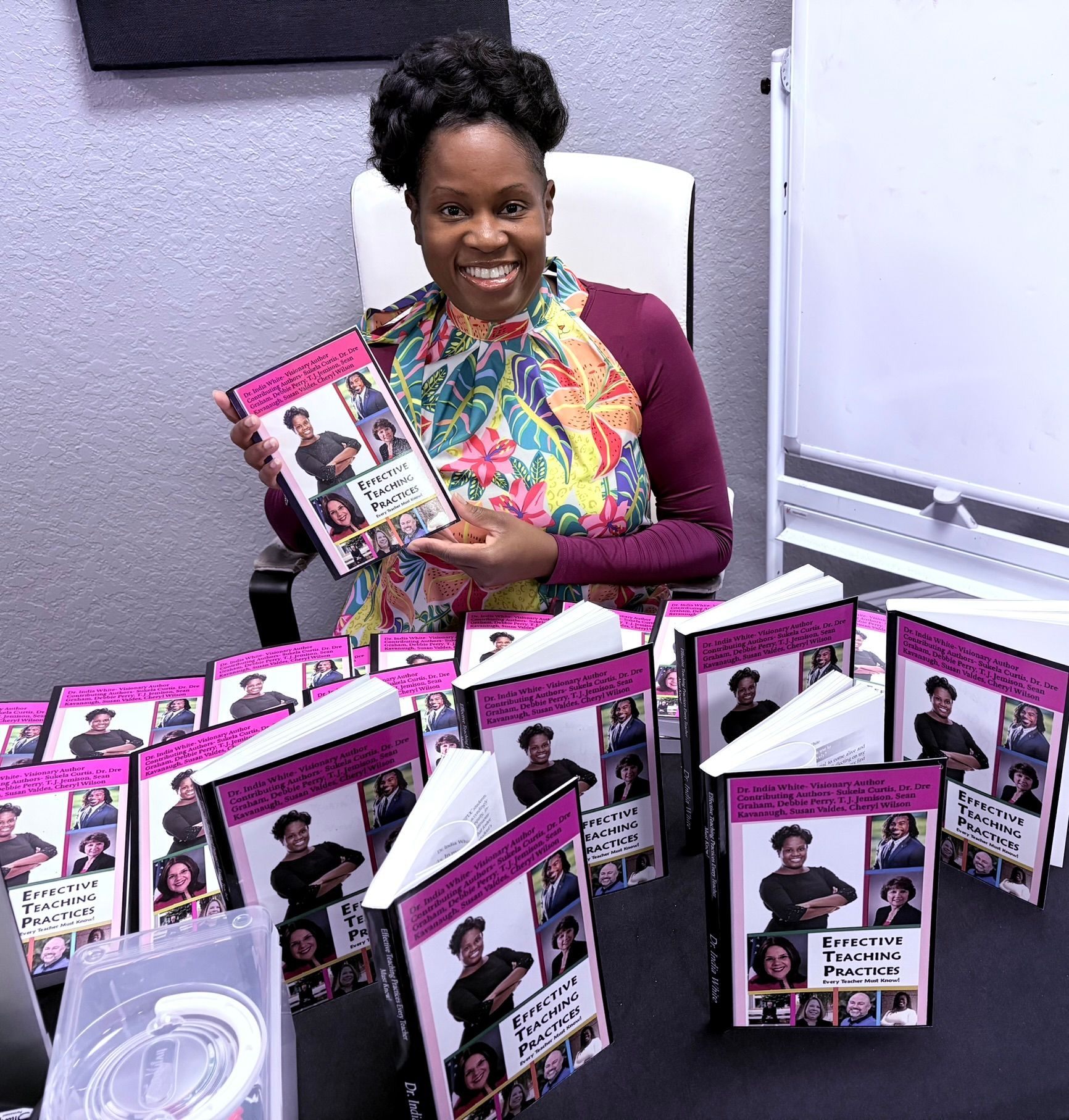
🚨 Exciting news! 📚 Our books have finally arrived, and orders are being shipped out! A huge thank you to the school districts and educators who have supported us by ordering their copies! 🙌 If you haven't grabbed yours yet, now's the time to get it! Don't miss out! Link- https://a.co/d/a6m9xoC ✨ hashtag#nctm hashtag#ncsm hashtag#drindiawhite hashtag#teachers hashtag#grit hashtag#Tedx
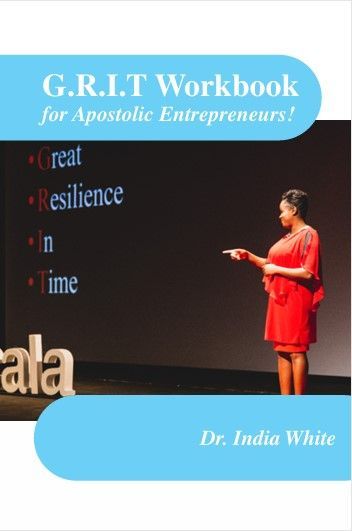
G.R.I.T. Workbook for Apostolic Entrepreneurs: Strengthening Faith and Endurance in the Marketplace Faith and entrepreneurship are not separate journeys—they are deeply intertwined. The G.R.I.T. Workbook for Apostolic Entrepreneurs is a faith-driven guide designed to help believers walk boldly in their calling as business leaders, visionaries, and kingdom builders. Authored by Dr. India White, this workbook combines biblical principles with her signature G.R.I.T. framework—Growth Mindset, Resilience, Self-Efficacy, and Time Management—to empower Apostolic entrepreneurs to endure, overcome, and finish strong. Rooted in the Word of God, this workbook reminds readers that entrepreneurship is not just about profit but about purpose. Through prayer, perseverance, and discipline, Apostolic entrepreneurs can honor God with their work while transforming communities and demonstrating Christlike leadership. Each page of this workbook points believers back to Jesus—the ultimate example of endurance and grace under pressure. In this workbook, entrepreneurs will explore how faith fuels vision, how adversity refines purpose, and how resilience develops through trials. It teaches how to balance ministry and business, stay grounded in prayer, and maintain spiritual integrity while navigating competitive markets. The workbook’s exercises encourage readers to apply Scripture to real-world challenges—aligning business decisions with godly wisdom and spiritual discernment. Each section integrates powerful themes: • Growth Mindset – Renewing the mind daily through the Word and trusting God’s process • Resilience – Overcoming trials by remembering God’s promises and grace • Self-Efficacy – Believing you can do all things through Christ who strengthens you • Time Management – Stewarding time as a divine resource for kingdom impact The G.R.I.T. Workbook for Apostolic Entrepreneurs serves as a devotional and strategic planner in one. It helps readers reflect, plan, and act with spiritual confidence, knowing that God has called them to be lights in the marketplace. It emphasizes that entrepreneurship, when aligned with the Apostolic faith, becomes an act of worship—a testimony of God’s power to prosper His people and sustain them through adversity. This workbook also includes journaling prompts, faith declarations, and vision-building activities that help believers overcome doubt and keep their eyes fixed on Jesus, the Author and Finisher of their faith. It encourages readers to endure to the end, to remain steadfast, and to let perseverance finish its work, just as Scripture commands. The G.R.I.T. Workbook for Apostolic Entrepreneurs will soon be available on Amazon. Visit www.india-white.com for updates, ministry resources, and information on G.R.I.T. Academy’s faith-based leadership programs. With Jesus as the foundation, grit becomes more than endurance—it becomes divine strength in action. Let this workbook guide you in building a business that glorifies God, uplifts others, and equips you to endure until the end.
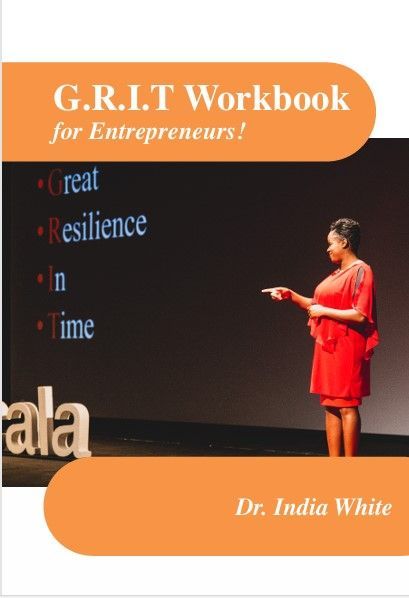
G.R.I.T. Workbook for Entrepreneurs: Building Resilience and Vision in Business The journey of entrepreneurship is full of challenges, uncertainty, and opportunity. To succeed, entrepreneurs need more than talent or strategy—they need grit. That’s why the G.R.I.T. Workbook for Entrepreneurs was created. Designed by Dr. India White, this new resource equips business leaders, innovators, and founders with practical tools to build perseverance, mental toughness, and long-term success. Available on Amazon , this workbook helps entrepreneurs develop the habits and mindset necessary to thrive in today’s demanding business landscape. It is based on Dr. White’s powerful G.R.I.T. framework—Growth Mindset, Resilience, Self-Efficacy, and Time Management—which has transformed lives in classrooms, boardrooms, and leadership settings across the nation. The workbook walks readers through self-assessments, reflection exercises, and guided strategies that strengthen mental stamina and leadership capacity. Each chapter encourages deep introspection and action, helping entrepreneurs embrace growth through challenges. From managing time effectively to cultivating resilience during setbacks, this workbook provides an organized, faith-centered approach to success that aligns values with vision. Inside the workbook, entrepreneurs will find tools such as personal grit trackers, resilience maps, goal-setting templates, and strategic planning pages that link passion to performance. Dr. White’s coaching prompts guide readers to develop self-efficacy—believing in their ability to make things happen—while maintaining balance and emotional clarity in leadership. For those building startups or managing established businesses, this workbook helps refine focus, strengthen leadership habits, and increase motivation. It reminds every entrepreneur that sustainable success doesn’t happen overnight—it’s forged through perseverance, adaptability, and unwavering determination. Soon available on Amazon, the G.R.I.T. Workbook for Entrepreneurs is more than a guide; it’s a companion for your business journey. Visit www.india-white.com for updates, training opportunities, and resources from G.R.I.T. Academy that will help you elevate your leadership, strengthen your mindset, and achieve lasting results. Great Resilience in Time—that’s the foundation of every successful entrepreneur. Prepare to build your legacy with grit, purpose, and perseverance.

Introducing the G.R.I.T. Workbook for Mentees — Cultivating Resilience, One Page at a Time I’m thrilled to share news of a powerful new resource that’s about to hit the shelves — the G.R.I.T. Workbook for Mentees, designed around Dr. India White’s G.R.I.T. framework. This workbook is specifically created for students working with mentors, helping them develop grit and resilience through reflection, accountability, and growth. While the workbook will soon be available on Amazon, here’s an inside look at what makes it special, why it matters, and how mentors and mentees can use it together. Why a Workbook for Mentees? Mentorship changes lives, but it works best when mentees are equipped to take ownership of their personal growth. The G.R.I.T. Workbook for Mentees bridges that gap by providing structured tools to build resilience and self-efficacy throughout the mentorship journey. It offers: * A clear roadmap for personal growth and reflection * Practical exercises for goal-setting and perseverance * Tools to track progress and measure growth over time * Prompts for deeper mentor–mentee discussions This workbook helps mentees turn challenges into opportunities and equips mentors with strategies to nurture lasting confidence and determination. Understanding Dr. India White’s G.R.I.T. Framework At the heart of this workbook lies Dr. India White’s signature G.R.I.T. framework — Great Resilience in Time. The framework teaches students how to thrive through four key pillars: Growth Mindset– Believing abilities can improve through effort and learning Resilience – Bouncing back from adversity stronger than before Self-Efficacy– Believing in one’s ability to accomplish tasks and goals Time Management– Using time wisely to achieve success Dr. White’s framework has been implemented in schools, leadership trainings, and G.R.I.T. Academy programs nationwide. The mentee workbook adapts these proven strategies into personalized activities designed to strengthen the mentor–mentee connection and support personal transformation. What’s Inside the Workbook Each section of the G.R.I.T. Workbook for Mentees is interactive and designed to make learning active and reflective. | Section | Purpose | How to Use It | |Self-Assessment | Identifies mentee’s current strengths and areas for growth | Use during first sessions to set a baseline | |Goal Setting & Reflection| Helps mentees develop SMART goals and revisit progress | Reflect weekly and discuss during check-ins | |G.R.I.T. Modules | Deep dives into Growth, Resilience, Self-Efficacy, and Time Management | Complete together or independently between sessions | |Challenges & Activities | Hands-on projects to practice perseverance | Mentors assign or co-design activities | Progress Tracking | Allows mentees to visualize their growth over time | Review regularly to celebrate milestones | The workbook ensures that each mentoring session becomes meaningful, measurable, and motivating. Benefits for Mentees and Mentors Mentees will: * Strengthen their confidence and self-discipline * Learn how to turn setbacks into comebacks * Set clear, attainable goals for personal and academic growth * Develop stronger reflection and problem-solving habits Mentors will: * Gain structured tools for meaningful sessions * Foster deeper conversations that go beyond surface-level topics * See measurable growth in their mentees over time * Cultivate a shared language around perseverance and purpose Grab a Copy on Amazon The G.R.I.T. Workbook for Mentees will soon be available on Amazon for mentors, coaches, and educators nationwide. This workbook serves as a companion to Dr. White’s G.R.I.T. Workbook for Mentors and aligns with her ongoing mission to build grit and resilience in every student. To get ready for launch: 1. Watch Dr. India White’s TEDx Talk, The Power of Grit. 2. Visit www.india-white.com for updates on release dates and resources. 3. Connect with Dr. White’s G.R.I.T. Academy for mentoring tools, training, and online courses. Final Thoughts The G.R.I.T. Workbook for Mentees isn’t just a book—it’s a movement toward empowerment, growth, and lasting change. It gives mentees a voice, a plan, and the courage to persevere through life’s challenges. Stay tuned for the Amazon launch announcement, and prepare to empower the next generation of students to rise with Great Resilience in Time.
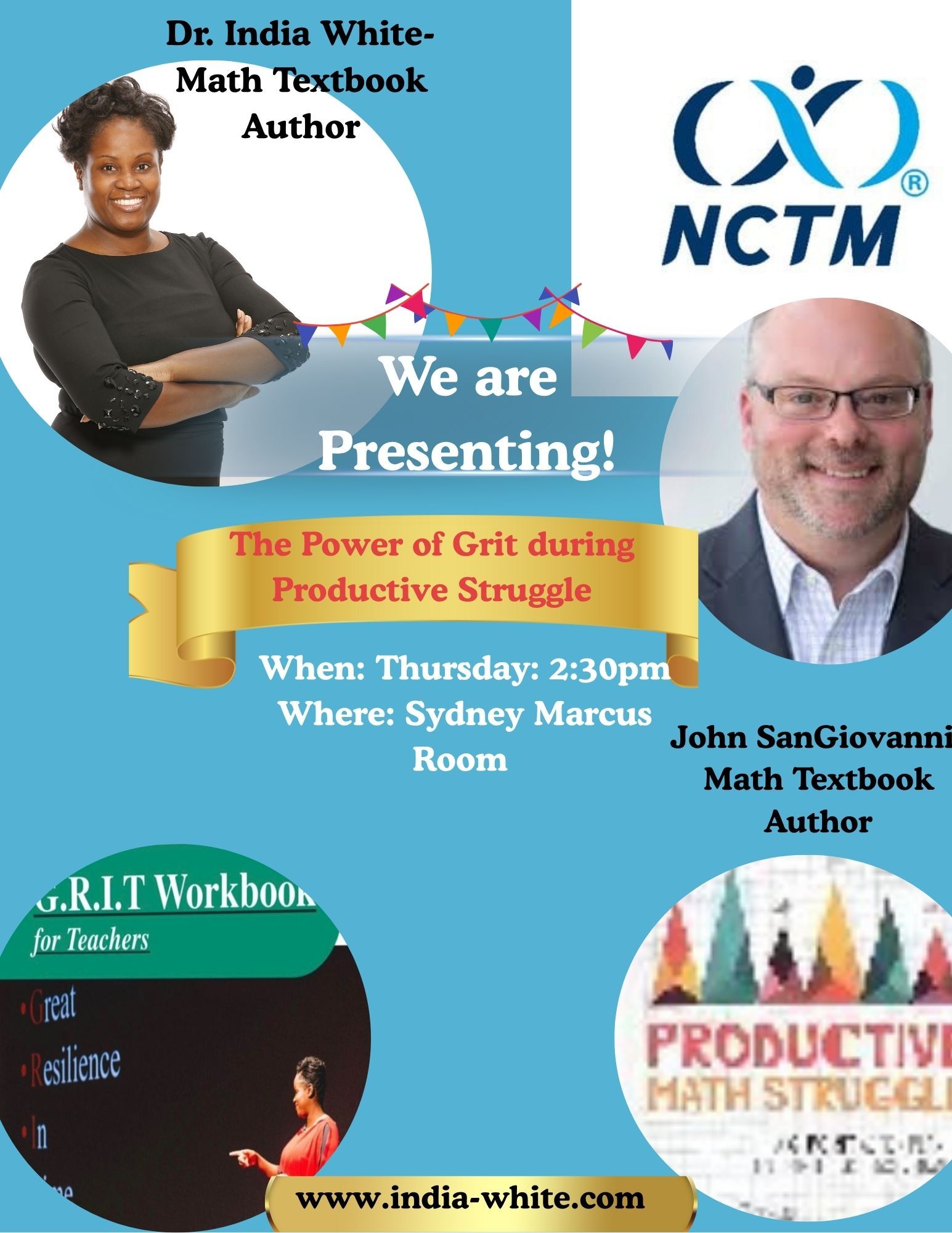
1 am excited to share that I will be a featured speaker at the NCTM 2025 Conference alongside the amazing John SanGiovanni. Together, we’ll explore the power of grit and productive struggle in the mathematics classroom—two essential ingredients for deep and lasting learning. John SanGiovanni will share his expertise on productive struggle, focusing on how teachers can design meaningful math experiences that challenge students to think critically, reason deeply, and persevere through complex problems. His work emphasizes that learning happens not when math is easy, but when students engage in struggle that leads to understanding and growth. In my portion of the session, I’ll discuss building grit through the G.R.I.T. Framework; Growth Mindset, Resilience, Self-Efficacy, and Time Management. Drawing from my G.R.I.T. Workbook for Educators, I’ll share practical tools and strategies educators can use to help students embrace challenges with confidence and persistence. By connecting grit to productive struggle, we can empower students to develop both the mindset and skills they need to overcome obstacles and achieve success in mathematics and beyond. I look forward to connecting with fellow educators at NCTM 2025 as we explore how to inspire perseverance, confidence, and a love for learning through grit and productive struggle.